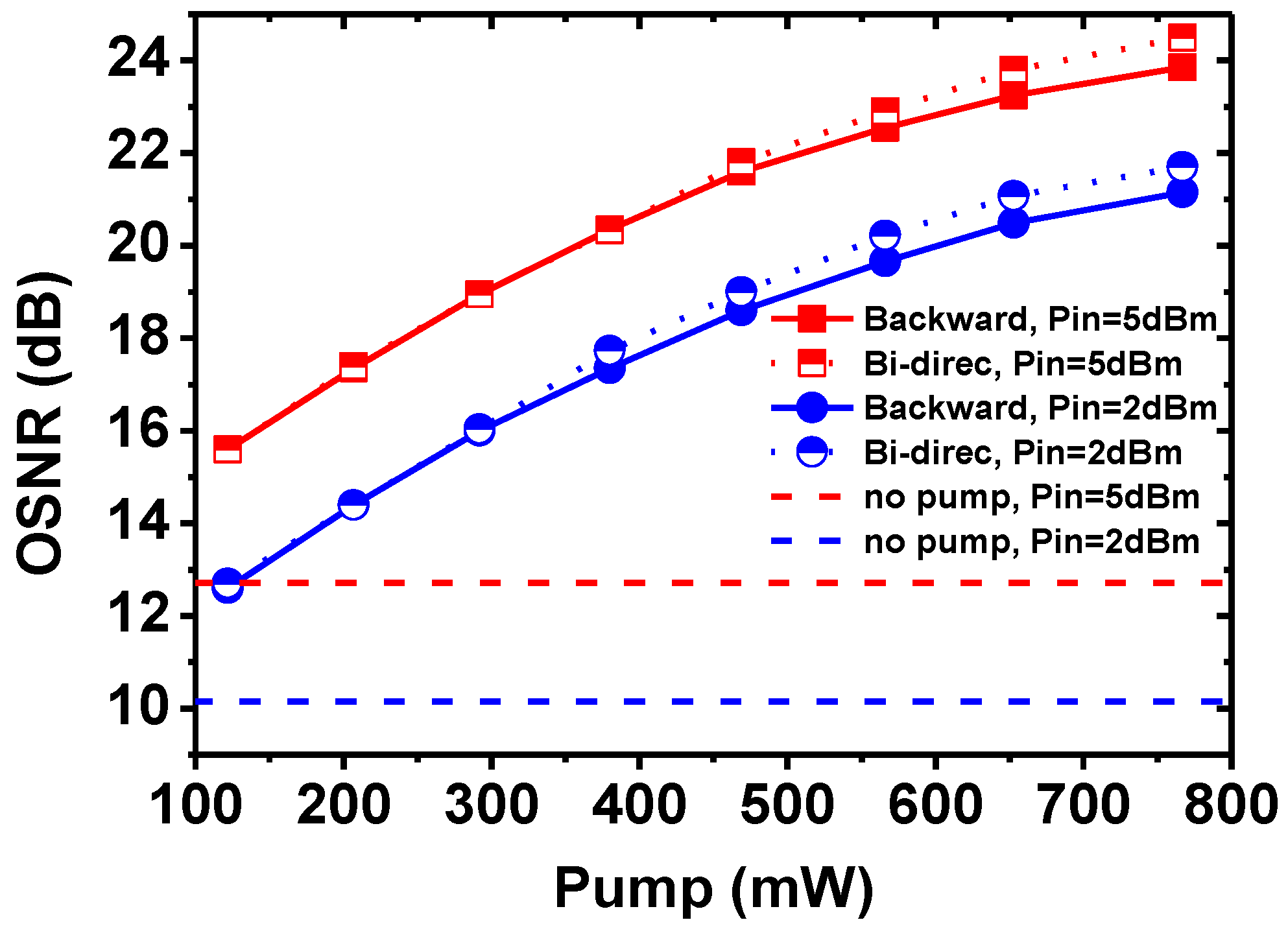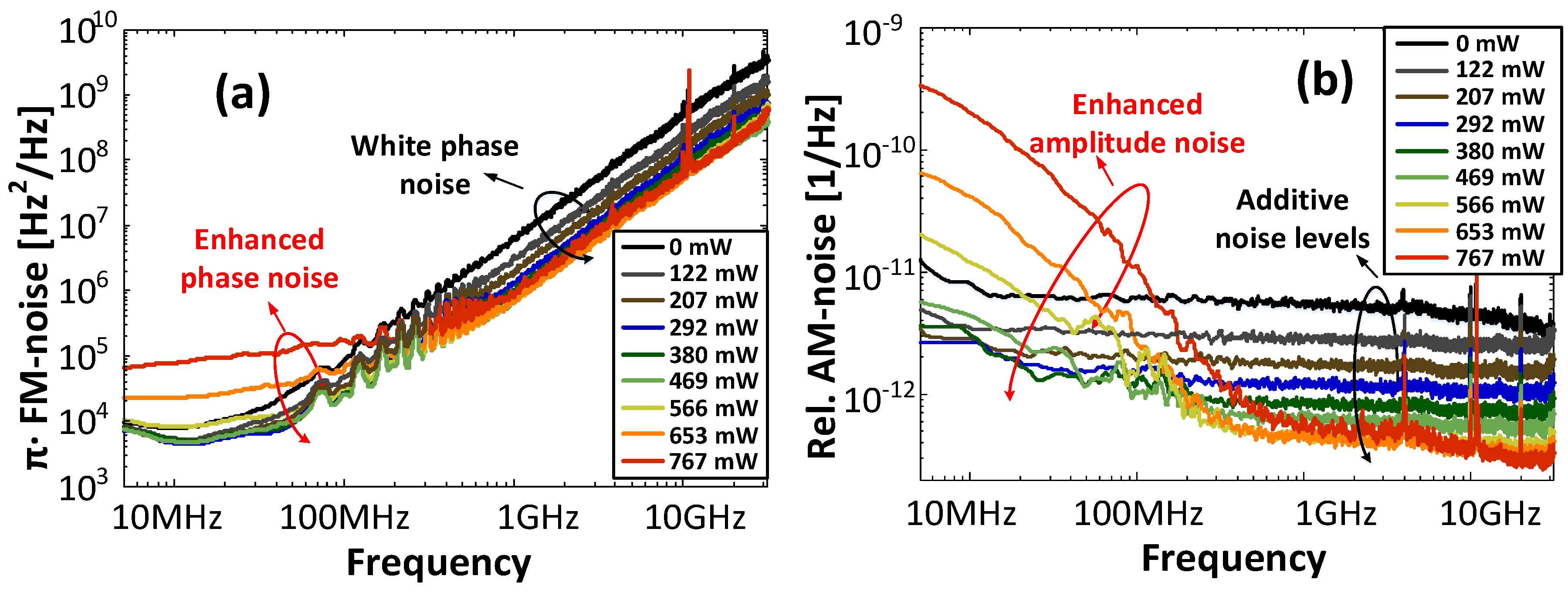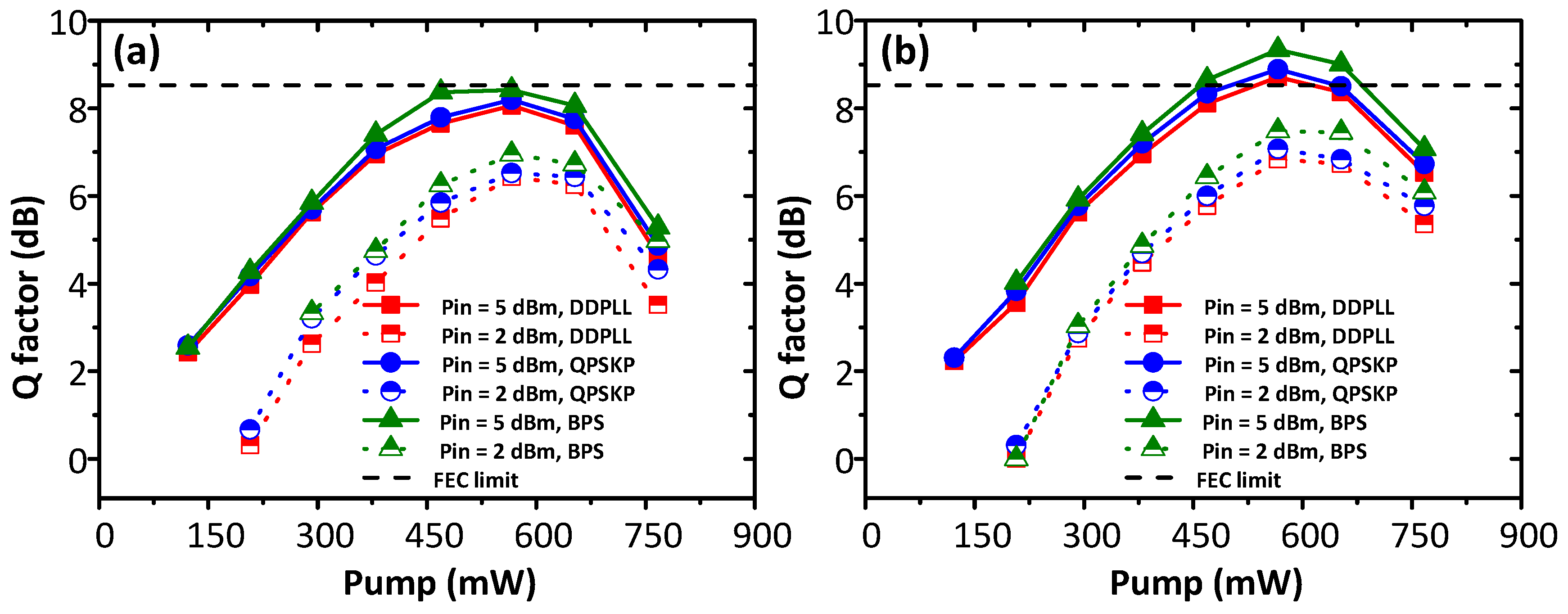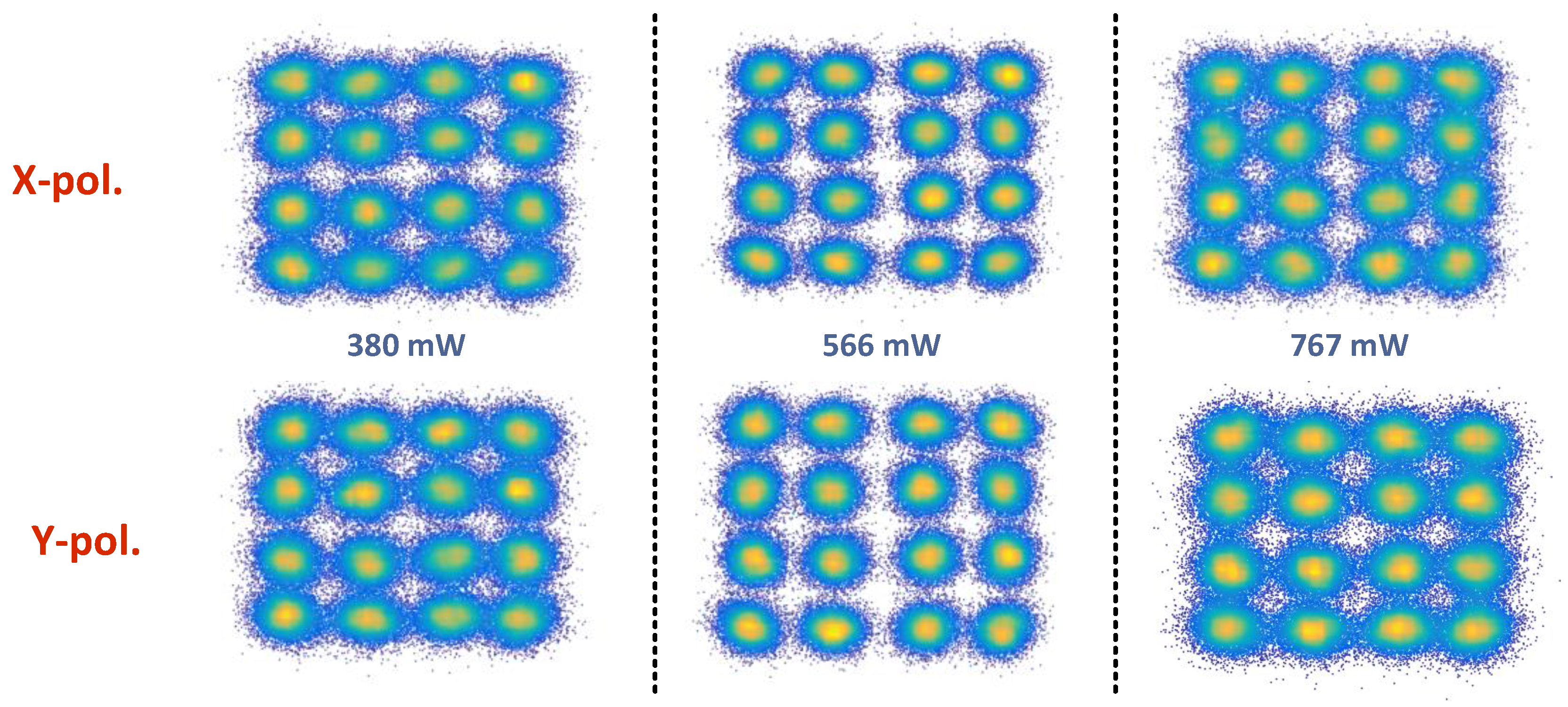Experimental Evaluation of Impairments in Unrepeatered DP-16QAM Link with Distributed Raman Amplification
Abstract
:1. Introduction
2. Experimental Setup
3. Results
4. Conclusions
Acknowledgments
Author Contributions
Conflicts of Interest
Abbreviations
| BPS | Blind Phase Search |
| CD | Chromatic Dispersion |
| CPR | Carrier Phase Recovery |
| DAC | Digital to Analog Converter |
| DDPLL | Decision-Directed Phase-lock-loop |
| DFRA | Distributed Raman Fiber Amplifier |
| DSO | Digital Storage Oscilloscope |
| DSP | Digital Signal Processing |
| ECL | External Cavity Laser |
| EDFA | Erbium Doped Fiber Amplifier |
| HD-FEC | Hard-Decision Forward Error Correction |
| IQ | In-phase and Quadrature-phase |
| LO | Local Oscillator |
| OBPF | Optical Bandpass Filter |
| PolMux | Polarization Multiplexing |
| PPG | Pulse Pattern Generator |
| PSD | Power Spectrum Density |
| RIN | Relative Intensity Noise |
| RPN | Relative Phase Noise |
| SSMF | Standard Single Mode Fiber |
| QPSK | Quadrature Phase Shift Keying |
| QPSKP | QPSK Partitioning |
| QAM | Quadrature Amplitude Modulation |
| VOA | Variable Optical Attenuator |
| WDM | Wavelength Division Multiplexer |
References
- Mori, Y.; Zhang, C.; Igarashi, K.; Katoh, K.; Kikuchi, K. Unrepeated 200-km transmission of 40-Gbit/s 16-QAM signals using digital coherent receiver. Opt. Express 2009, 17, 1435–1441. [Google Scholar] [CrossRef] [PubMed]
- Chang, D.; Pelouch, W.; McLaughlin, J. 8 × 120 Gb/s unrepeatered transmission over 444 km (76.6 dB) using Distributed Raman Amplification and ROPA without Discrete Amplification. In Proceedings of the European Conference and Exhibition on Optical Communications (ECOC), Geneva, Switzerland, 19–21 September 2011.
- Oda, S.; Tanimura, T.; Cao, Y.; Hoshida, T.; Akiyama, Y.; Nakashima, H.; Ohshima, C.; Sone, K.; Aoki, Y.; Yan, M.; et al. 80 × 224 Gb/s Unrepeated Transmission over 240 km of Large-Aeff Pure Silica Core Fibre without Remote Optical Pre-amplifier. In Proceedings of the European Conference and Exhibition on Optical Communications (ECOC), Geneva, Switzerland, 19–21 September 2011.
- Meloni, G.; Potì, L.; Di Nezza, E.; Cavaliere, F.; D’Errico, A.; Magri, R.; Ricci, G. Unrepeated Link Distance Increase for 448 Gb/s Channel Transmission by using Large Core Area. In Proceedings of the European Conference and Exhibition on Optical Communications (ECOC), Geneva, Switzerland, 19–21 September 2011.
- Downie, J.D.; Hurley, J.; Roudas, I.; Pikula, D.; Garza-Alanis, J.A. Unrepeatered 256 Gb/s PM-16QAM transmission over up to 304 km with simple system configurations. Opt. Express 2014, 22, 10256–10261. [Google Scholar] [CrossRef] [PubMed]
- Rosa, P.; Ania-Castañón, J.-D.; Harper, P. Unrepeatered DPSK transmission over 360 km SMF-28 fibre using URFL based amplification. Opt. Express 2014, 22, 9687–9692. [Google Scholar] [CrossRef] [PubMed]
- Galdino, L.; Tan, M.; Lavery, D.; Rosa, P.; Maher, R.; Phillips, I.D.; Castañón, J.D.A.; Harper, P.; Killey, R.I.; Thomsen, B.C.; et al. Unrepeatered Nyquist PDM-16QAM transmission over 364 km using Raman amplification and multi-channel digital back-propagation. Opt. Lett. 2015, 40, 3025–3028. [Google Scholar] [CrossRef] [PubMed]
- Fludger, C.R.S.; Handerek, V.; Mears, R.J. Pump to Signal RIN Transfer in Raman Fiber Amplifiers. J. Lightwave Technol. 2001, 19, 1140–1148. [Google Scholar] [CrossRef]
- Krause, M.; Cierullies, S.; Renner, H.; Brinkmeyer, E. Pump-to-Stokes RIN transfer in Raman fiber lasers and its impact on the performance of co-pumped Raman amplifiers. Opt. Commun. 2006, 260, 656–661. [Google Scholar] [CrossRef]
- Martinelli, C.; Lorcy, L.; Durecu-Legrand, A.; Mongardien, D.; Borne, S.; Bayart, D. RIN transfer in co-pumped Raman amplifiers using polarization-combined diodes. IEEE Photonics Technol. Lett. 2005, 17, 1836–1838. [Google Scholar] [CrossRef]
- Popov, S.; Vanin, E.; Jacobsen, G. Polarization dependence of gain in discrete Raman amplifiers with dispersion compensating fibres. J. Opt. A Pure Appl. Opt. 2002, 4, 46–51. [Google Scholar] [CrossRef]
- Popov, S.; Sergeyev, S.; Friberg, A.T. The impact of pump polarization on the polarization dependence of the Raman gain due to the breaking of a fibre’s circular symmetry. J. Opt. A Pure Appl. Opt. 2004, 6, S72–S76. [Google Scholar] [CrossRef]
- Sergeyev, S.; Popov, S.; Friberg, A.T. Spun fiber Raman amplifiers with reduced polarization impairments. Opt. Express 2008, 16, 14380–14389. [Google Scholar] [CrossRef] [PubMed]
- Sergeyev, S.; Popov, S. Two-section fiber optic Raman polarizer. IEEE J. Quantum Electron. 2012, 48, 56–60. [Google Scholar] [CrossRef]
- Popov, S.; Vanin, E. Polarization dependence of Raman gain on propagation direction of pump and probe signal in optical fibers. In Proceedings of the Lasers and Electro-Optics (CLEO), Baltimore, MD, USA, 6–11 May 2001.
- Cheng, J.; Tang, M.; Fu, S.; Shum, P.P.; Liu, D. Relative phase noise induced impairment in M-ary phase-shift-keying coherent optical communication system using distributed fiber Raman amplifier. Opt. Lett. 2013, 38, 1055–1057. [Google Scholar] [CrossRef] [PubMed]
- Cheng, J.; Tang, M.; Fu, S.; Shum, P.P.; Liu, D.; Xiang, M.; Feng, Z.; Yu, D. Relative phase noise estimation and mitigation in Raman amplified coherent optical communication system. Opt. Express 2014, 22, 1257–1266. [Google Scholar] [CrossRef] [PubMed]
- Cheng, J.; Tang, M.; Fu, S.; Shum, P.P.; Yu, D.; Wang, L.; Liu, D. Relative Phase noise-Induced Phase Error and System Impairment in Pump Depletion/Nondepletion Regime. J. Lightwave Technol. 2014, 32, 2277–2286. [Google Scholar]
- Cheng, J.; Tang, M.; Lau, A.P.T.; Lu, C.; Wang, L.; Dong, Z.; Bilal, S.M.; Fu, S.; Shum, P.P.; Liu, D. Pump RIN-induced impairments in unrepeatered transmission systems using distributed Raman amplifier. Opt. Express 2015, 23, 11838–11854. [Google Scholar] [CrossRef] [PubMed]
- Xu, L.; Cheng, J.; Tang, M.; Wu, J.; Fu, S.; Shum, P.P.; Liu, D. Experimental Verification of Relative Phase Noise in Raman Amplified Coherent Optical Communication System. J. Lightwave Technol. 2016, 34, 3711–3716. [Google Scholar]
- Tan, M.; Rosa, P.; Le, S.-L.; Phillips, I.-D.; Harper, P. Evaluation of 100G DP-QPSK long-haul transmission performance using second order co-pumped Raman laser based amplification. Opt. Express 2015, 23, 22181–22189. [Google Scholar] [CrossRef] [PubMed]
- Pang, X.; El-Taher, A.; Schatz, R.; Popov, S.; Jacobsen, G.; Sergeyev, S. Characterization of Distributed Raman Amplification-induced Amplitude and Phase Impairments on Unrepeated Coherent Transmission Links. In Proceedings of the Asia Communications and Photonics Conference (ACP), Shanghai, China, 11–14 November 2014.
- El-Taher, A.; Pang, X.; Schatz, R.; Popov, S.; Jacobsen, G.; Sergeyev, S. Noise Characterization and Transmission Evaluation of Unrepeated Raman Amplified DP-16QAM Link. In Proceedings of the Optical Fiber Communication Conference and Exhibition (OFC), Anaheim, CA, USA, 17–21 March 2013.
- Borkowski, R.; Zibar, D.; Tafur Monroy, I. Anatomy of a Digital Coherent Receiver. IEICE Trans. Commun. 2014, E97-B, 1528–1536. [Google Scholar] [CrossRef]
- Zhong, K.; Ke, J.H.; Geo, Y.; Cartledge, J.C. Linewidth-Tolerant and Low-Complexity Two-Stage Carrier Phase Estimation Based on Modified QPSK Partitioning for Dual-Polarization 16-QAM Systems. J. Lightwave. Technol. 2013, 31, 50–57. [Google Scholar] [CrossRef]
- Pfau, T.; Hoffman, S.; Noé, R. Hardware-Efficient coherent digital receiver concept with feed forward carrier recovery for m-QAM constellations. J. Lightwave. Technol. 2009, 27, 989–999. [Google Scholar] [CrossRef]
- Rodrigo Navarro, J.; Kakkar, A.; Pang, X.; Iglesias Olmedo, M.; Ozolins, O.; Da Ros, F.; Piels, M.; Schatz, R.; Zibar, D.; Jacobsen, G.; et al. Two-Stage n-PSK Partitioning Carrier Phase Recovery Scheme for Circular mQAM Coherent Optical Systems. Photonics 2016, 3, 37. [Google Scholar] [CrossRef]
- Kikuchi, K. Characterization of semiconductor-laser phase noise and estimation of bit-error rate performance with low-speed offline digital coherent receivers. Opt. Express 2012, 20, 5291–5302. [Google Scholar] [CrossRef] [PubMed]





© 2017 by the authors. Licensee MDPI, Basel, Switzerland. This article is an open access article distributed under the terms and conditions of the Creative Commons Attribution (CC BY) license ( http://creativecommons.org/licenses/by/4.0/).
Share and Cite
Pang, X.; Ozolins, O.; El-Taher, A.; Schatz, R.; Jacobsen, G.; Sergeyev, S.; Popov, S. Experimental Evaluation of Impairments in Unrepeatered DP-16QAM Link with Distributed Raman Amplification. Photonics 2017, 4, 16. https://doi.org/10.3390/photonics4010016
Pang X, Ozolins O, El-Taher A, Schatz R, Jacobsen G, Sergeyev S, Popov S. Experimental Evaluation of Impairments in Unrepeatered DP-16QAM Link with Distributed Raman Amplification. Photonics. 2017; 4(1):16. https://doi.org/10.3390/photonics4010016
Chicago/Turabian StylePang, Xiaodan, Oskars Ozolins, Atalla El-Taher, Richard Schatz, Gunnar Jacobsen, Sergey Sergeyev, and Sergei Popov. 2017. "Experimental Evaluation of Impairments in Unrepeatered DP-16QAM Link with Distributed Raman Amplification" Photonics 4, no. 1: 16. https://doi.org/10.3390/photonics4010016





